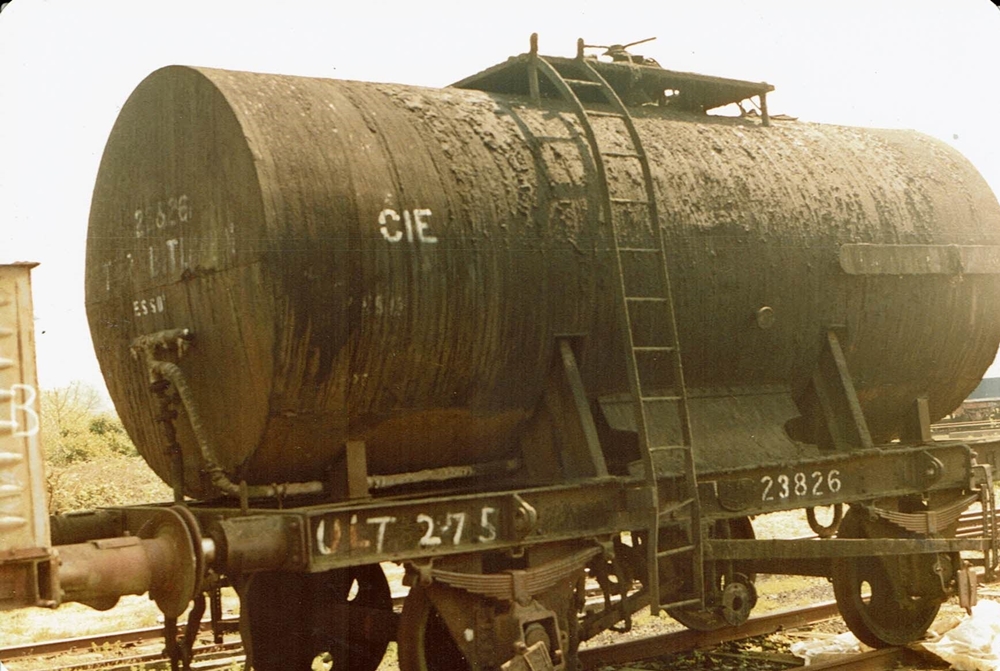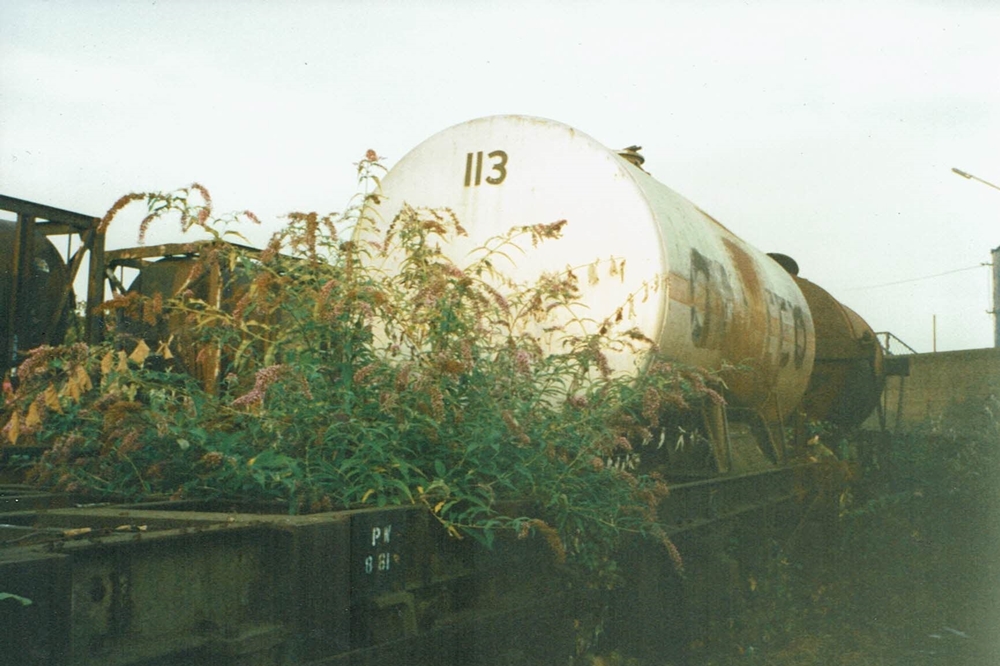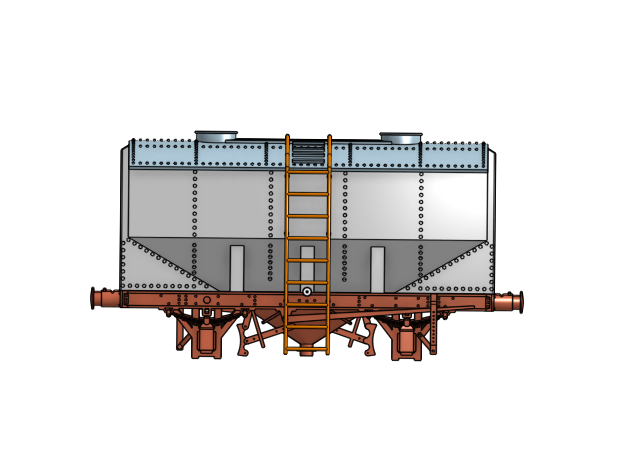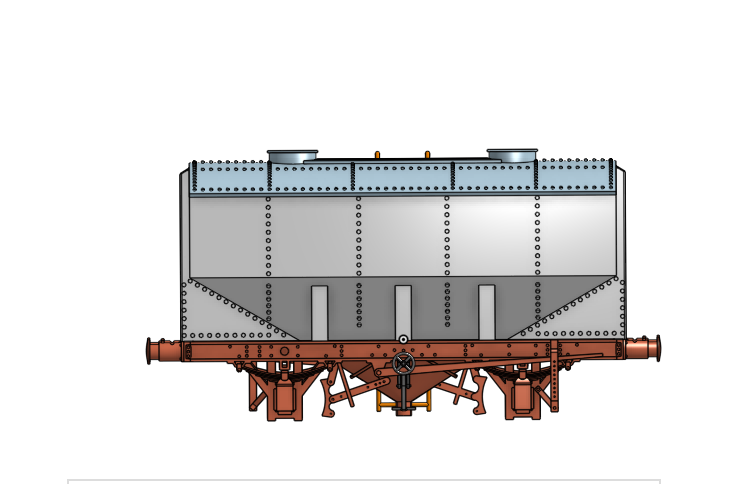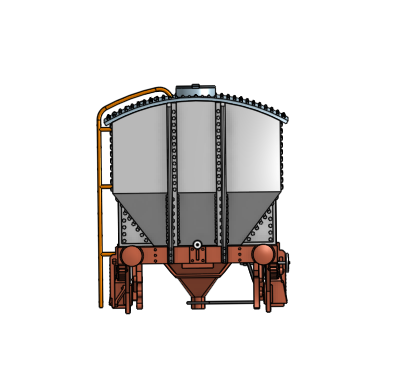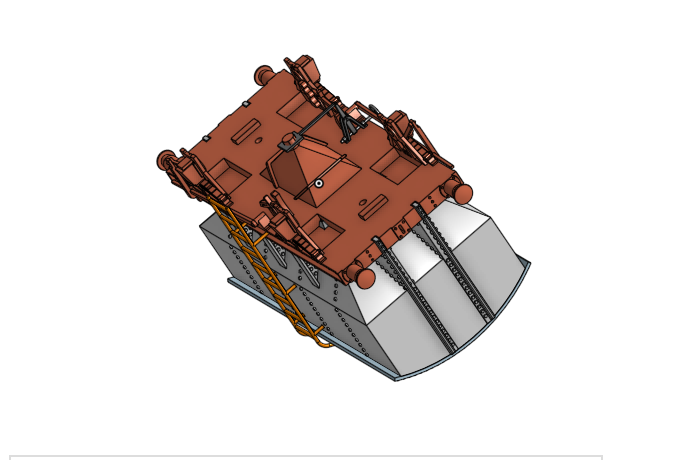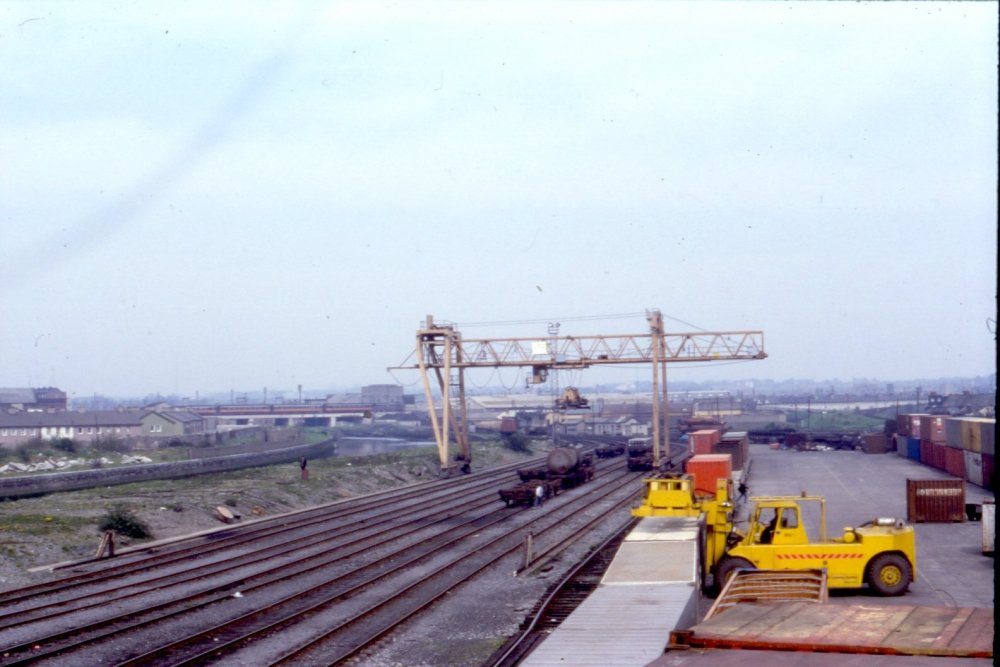-
Posts
4,863 -
Joined
-
Last visited
-
Days Won
119
Content Type
Profiles
Forums
Events
Gallery
Blogs
Store
Community Map
Everything posted by Mayner
-
No 98 on test. I set up a OO gauge test track in a corner of the garage using Hornby No 3 curved & straight track on some offcuts of ply to test 98s haulage capabilities starting with 12 MIR hoppers. The hesitation at one point of the run seems to be a misaligned rail joiner. High Speed Test Run! Turned out to be a bit too much for one of the wagons!
-
The oil burning conversions was a short term measure by CIE to keep trains moving during the winter of 1947, when coal supplies from the UK failed as a result of severe weather conditions in the UK https://en.wikipedia.org/wiki/Winter_of_1946–47_in_the_United_Kingdom. The main issue with oil burning on CIE seems to be that oil firing with its rapid heating and cooling was severe on locomotive boilers and fireboxes and lead to maintenance problems and shortened boiler life on an already run down locomotive fleet. Oil burning tended to be used to achieve higher power outputs than could be achieved with hand firing and in the post WWII era when it became increasingly difficult to recruit staff to carry out menial dirty tasks such as cleaning and disposal work on steam locomotives. Despite ample coal supplies New Zealand Railways built both coal and oil fired versions of its Ka 4-8-4 and Ja 4-8-2 class locomotives for its heaviest main line duties. https://en.wikipedia.org/wiki/NZR_JA_class.
-

Bord na Mona Kilberry siding and Athy questions?
Mayner replied to murphaph's topic in What's happening on the network?
Rail traffic from the Kilberry & Coolnamona (near Portlaoise) Peat Moss plants appear to have ceased in the late 60s early 70s when BNM acquiring its onw fleet of trucks. Its possible Kilberry Siding was disconnected when the Cherryville Junction-Athy section was converted to CTC control around 1975, although Athy was scheduled to close to goods traffic under the Rail Plan 80 scheme Athy the sidings on the down side continued to handle goods traffic until the Dublin-Waterford line went over the Liner operation at some stage in 78. During the final months/year of operation traffic appears to have been handled in CIE side door and half height containers on 20' container flats rather than H Vans and corrugated open wagons. Presumably the down side goods yard sidings were disconnected at some stage after the station closed to goods traffic. -
The GSWR diagram of the 0-4-4BT together with other GSWR Classes was published with New Irish Lines 3-4 years ago. Alan O'Rourke the New Irish Lines editor may be able to help alanorourke@hotmail.com.
-
I haven't really gotten round to testing her haulage capability, she ran at a few exhibitions in Ireland in the early 20s, but train length was restricted to 5-6 coaches and I haven't had the chance to run her on a large continuous run layout. "Bodmin" 34016 was originally built for use on the Milton Keynes Model Railway Society EM gauge "Milton Quays" layout I was a member of the club when I was living in the UK during the 90s, but built the loco after I returned to Ireland. Due to double reduction gearing and a large can motor her top speed is low for express passenger work on a continuous run layout but ideal in a terminal fiddle yard situation.
- 77 replies
-
- 10
-

-

-
I have a sneaking suspicion that WARB is planning to model the Belmond Grand Hibernian rather than an IE MK3 Intercity set. Apart from Pearse-Drogheda Push Pull workings and the odd Push-Pull working down the DSER main line MK3 stock would have been extremely rare at Barrow Street Boston Yard area. The carriage sidings between Pearse Station & Grand Canal Dock were used during the IE era for reversing Pearse-Drogheda and Maynooth services and stabling stock the evening rush hour services. Westland Row (Pearse) was the terminus for Midland Main Line services (Galway, Sligo, Westport) from the late 30s until the services were diverted to run from Heuston or Connolly during the 1970s. The Midland trains apparently were stabled in the bay platforms at the south end of the station before being propelled out onto the main line immediately before departure. I remember watching light engine movements with a black and tan B121 between Grand Canal Shed and the station from Townsend Street as a 7-8 year old on a saturday morning as my father was getting parts in a motor factors.
-
A Nohab is certainly a possibility NOHAB tendered to supply locos to the GNR (I) during the 1950s possibly its standard European and North African GM powered design. The proposal was for a GM powered A1A A1A which was too long to fit the Dundalk Works traverser.
-
The other major benefit of building your own locos is that none that I built myself have been effected by problems with mazac rot, plastic rot and split gears that afflicted certain Bachmann, Hornby and Heljan locos introduced during the last 20 years.
-
The formation is shown but no track on the 1888-1914 historic map. Its possible a connection may have been put in for construction purposes or even to allow WLWR trains to run to Sligo if the MGWR & WLWR were in dispute over the provision and use of Collooney Junction. The MGWR would not have been exactly happy about the WLWR and later GSWR incursion into its territory and may have attempted to block the WLWR accessing the MGWR line at Collooney Junction. In Dublin fighting broke out between rival groups of workers at the "Battle of Newcomen Bridge" when contractor attempted to enter MGWR property to install the junction between the MGWR Liffey Branch and the Loop Line from Amiens Street Station. A triangle would have been extremely useful for turning locos during pre-amalgamation days when the WLWR/GSWR and SLNCR interchanged goods traffic at Collooney and avoided the WLWR/GSWR paying for light engine mileage over the Midland to Sligo. Traffic between the Southern & SLNCR was interchanged at Sligo Quay following the Amalgamation and Collooney Southern down graded in status, but the SLNCR & MGWR stations appear to have remained a major shipping points for cattle traffic until the SLNCR closed and the traffic ceased on CIE.
-
I went through a phase of modelling large BR steam locos from DJH and Comet kits about 20 years ago. Great sense of achievement building one loco a year despite being followed a year or so later by a Bachmann or Hornby rtr version. Some friends in the UK even thought my West Country Pacific was a Hornby pre-production version.
-
Most likely in GNR wagons from Dublin, Belfast or possibly Derry Port's as Airfixfan pointed out the CDJR tank wagons were used to transport oil traffic from Derry to Killybegs and other points on the system. Its possible tar traffic for Glenfarne was imported through Dublin Port and routed via Dundalk and Enniskillen rather than via Mullingar. The SLNCR & the GNR competed seriously with the GSR and CIE for traffic from the Dublin and the East Coast to Sligo. Its just about possible that a wagon load of tar or bagged cement might arrive in Rosses Point in a GN wagon having travelled under customs bond through County Fermanagh
-
Traditionally Tar/Bitumen was transported in 45gal drums in open wagon on the Irish Railway system with CIE 1st introducing tank wagons for tar traffic in the 1950s. The Florencecourt and Glenfarne on the SLNCR appear to have the railheads for the local County Council depots. In most photos of Glenfarne the loading bank is literally covered in tar barrels, while there is a cut of 4 opens with tar traffic awaiting unloading in a photo of Florencecourt. A series of County Council & CIE depots were opened in the early 1960s to handle tar traffic. Some of the Council depots such as Cahir (Abbey Siding) & Lixnaw were served by private siding while other depots were in existing CIE goods yards Ballingarne and Tralee Rock Street. There is an interesting sequence of photos of the Tralee-Listowel goods setting out a CIE tank wagon, including the loco and train propelling the wagon along the main line from Lixnaw Station to the County County Siding. In the 1950s CIE bought several batches of Tar Tank wagons from Charles Roberts these were similar in appearance to the Bachmann 14T Anchor Mounted Tank Wagons but with an insulated tank barrel https://www.bachmann.co.uk/product/14t-class-a-anchor-mounted-tank-wagon-'national-benzole'/38-778. These wagons seem to have been based on a standard RCH design complete with independent either side brakes unusual in Ireland but standard practice for private Owner Mineral and Tank wagons on the UK Mainland. CIE started to build Tar Tank wagons during the early 60s on a standard Irish underframe with Irish style brake gear but an anchor mounted barrel similar to the Charles Roberts wagons. I think the "Jumbo" wagons may have been modified ESSO 22T Bitumen Tankers the ladders moved to the ends because of increased thickness of insulation. Wagon 997 in the late 1970s IRRS Journal photo appears to be a TSO34A wagon with domed ends and original tank mounts as in https://paulbartlett.zenfolio.com/essobitumenvb The ladder position on the wagons in the Sligo Deepwater Quay 1995 photo in the same journal is unclear. The 22.5ton axleload of 45GLW UK tank wagons would have substantially exceeded CIE axleload limits, the Sligo Deepwater branch was re-laid to 23826 is an out of use CIE built wagon, not sure of the location although I took the photo one of the few remaining loose coupled wagons that survived into the 80s. The ISO Bitumen Containers were a standard insulated framed containers similar to https://www.meeberg.com/en/new-products/bitumen/20-ft-bitumentank/. Its possible the containers were privately owned or supplied by CIE. The containers were allover black with panels in the bracing bays at one end with product details. From memory the details were "Cationic Road Emulsion and Cut Back Bitumen" in large black lettering on a yellow or orange background above smaller orange or white lettering on black panels possibly with supplier details. As a rule is that from the mid-1950s to the end of loose coupled working in the late 70s bitumen was transported in individual wagons loads (often 1 wagon!) to private sidings and CIE goods yards in Charles Roberts built wagons similar to The Bachmann 14T anchor mounted tank wagon or CIE built wagons. ESSO appears to have imported a small number of 22T Bitumen tank wagons when it modernised its wagon fleet in the late 60s, the ESSO 22T wagons appear to have run as individual wagons loads to destinations including Cahir on the Waterford-Limerick line in addition to the North Wall Sligo Oil trains. Bitumen Traffic by individual wagons load appears to have ceased in 78 with the closure of rail served depots such as Cahir, Ferns, Lispole, Oranmore and Sligo Deepwater Quay. Wagon load traffic to Cold Chon at Sligo Deepwater Quay was revised in the mid 1990s but may have ceased by 1999 and the Deep Water Quay line lifted in 2002. Although intended to operate as de-mountable the Bitumen containers seem to have been treated as wagons both loading and discharging on the rail, they usually seem to have been mounted on 20' skeletal flats, with several seemingly dumped for many years in the Dardanelles Sidings before the yard was cleared out in the early 2000. An interesting place but difficult to take a decent photo. Two bitumen containers just about visible on 4w flats in the Dardanelles Sidings during the late 90s. At the time I was more interested in 113 an early 160s Texaco Class A tank wagon, the original Caltex lettering had bled through after the wagon was re-branded. A rake of these wagons was used on the North Wall Inchacore fuel oil train until replaced with CIE stores wagons in the late 70s possibly the last loose coupled good train in the Dublin area.
-
The ESSO Teo Bitumen tank wagons appear to have been re-gauged from ESSO 22T Bitumen wagons built in the late 1950s rather than the 45GLW type like the Bachmann model which would have been too heavy to run in Ireland There is a good selection of photos on ESSO 22T Bitumen Tank Wagons in their original condition in https://paulbartlett.zenfolio.com/essobitumenvb. Many of the UK tanks were re-built with revised running gear and tank mounting. Railborne bitumen traffic to Cold Chon Sligo was a short lived 90s revival, IE discontinued bitumen traffic by individual wagon load during the mid 1970s transporting the traffic in ISO containers with road transfer to distributors such as Cold Chon, Irish Tar and Bitumen and Council Depots. Esso Teo appears to have stored its relatively modern (by Irish standards) 22T Bitumen tankers which appear to have been re-used when the Sligo quayside siding was re-opened during the 1990s. Oranmore was the rail head for Bitumen, Oil and Scrap Metal traffic in the Galway area until the sidings were disconnected in the late 70s, bitumen and scrap transported by Liner Train in ISO containers with a road transfer from Galway, ESSO oil traffic apparently transferring to coastal shipping. Oranmore would have been interesting in wagon load days Chold Chon used a Scammell Road road tractor on rail wheels as a year shunter.
-
Just to confirm that the JM Design CIE 20T goods brake will be produced as a rtr model starting with the 1950s-early 60s flying snail version our printer has successfully re-located his business to a new premises. There are a number of traditional loose coupled wagons in the pipeline based on the Standard IRCH 9'6" steel underframe which will be announced once we have completed the CAD work or a pre-production sample.
- 77 replies
-
- 14
-

-

-
A glimpse of our next traditional Irish goods wagon. Pre-production renderings of the GSR Bulk Grain wagon. We expect to have a pre-production sample ready by March 2021. These wagons were quite an advanced design by the standards of the 1930s. Our 20T Brake Van has been a test of what could practically be achieved in terms of detail and standard of finish with 3D printing and we are taking this a step further with the ladder and modelling the discharge gear. The company and private owner versions of the grain wagons operated from the mid 1930s until CIE phased out loose coupled operation and closed private mill sidings during the mid 1970s. We expect to make a decision on whether the wagons will be produced in kit or rtr form by mid February the majority of our suppliers having returned to work after the Christmas/Southern Hemisphere Summer Holidays.
- 9 replies
-
- 14
-

-
I did not realise that IE used the "Tar Wagons" during the 1990s as tar traffic was transported in ISO tank containers after CIE went over to Liner Train operation during the late 70s. There is a photo feature on private sidings in the February 2019 Journal which includes photos of operations at a number of sidings which handles tar traffic including Sligo Quay, Cahir Abbey Siding, Webbs Mill (Mallow) & Lixnaw. The "Jumbo" Tar wagons look suspiciously like an insulated version of the re-gauged Charles Roberts tank wagons imported by ESSO Teo from the UK during the late 60s. There is a reasonable photo of one of these wagons at Cahir and a more distant view of a pair at Sligo Quay. A number of these wagons were stored out of use for many years at the Point Yard after the ending of loose coupled traffic and brought back into use with the re-opening of Sligo Quay during the 1990s, presumably ESSO/Cold Chon were able to negotiate a lower freight rate with IE for using their own wagon than an ISO tank container and IE wagon. The Heljan or Dapol ESSO type A tank wagons would be a good basis for these wagons though the body would need serious modification, Bachmann appear to produce a model of a 45T BR tar tank wagon which is quite different design and larger than the ESSO Teo Tar Tank wagons. Over the fence view of out of use ESSO "Jumbo" Tar Wagon at North Wall Point Yard c. 1982-3. I was more interested in the Mex tank wagon at the time. A number of the Jumbo tank wagons were stored/dumped in the Dardanelles Yard by the Sheriff St level crossing until the yard was cleared out c2002
-
The Nenagh Line was treated a Main Line with through Dublin-Limerick passenger and goods trains routed by Nenagh until the line was downgraded to branch line status and all through trains routed by Limerick Junction during the early 80s
-
The Kibri gantry is not unlike those used by CIE in larger years like Heuston Goods and the North Wall during the 70s The gantries appear to have been a modular design that could be set up for specific sites varying from single to multiple sidings. The forklift is similar in size to those used for container handling at yards like Ballinasloe, Galway and Tralee where gantries were not provided.
-
Just to prove that an ex-T&D 2-6-0T will run round the curves on the tramway section. 6T with a short goods. The loco was the last of the "Kerrymen" to be transferred to the C&L arriving in 1957 to assist with the final upsurge in coal traffic, the loco is again based on a photo in "Irish Railways in Colour" black with patched side tanks and hand painted number on the buffer beam. One of two T&D Hunslets assembled from Branchlines kits during the late 90s and identical mechanically 6T has always been noisier and less free running than her sister 3T but is starting to improve as her gears bed in while 3T starts to shake herself to pieces. I must do something about that squeaky tripod!
-
I staged a shot once with a line up of photographers at the bridge, but they fell over in shock when the train swept around the curve. I'll have to add a Bently at some stage, fuchsia hedging on the roadside section & cattle wagons to go with the T&D engines for a Dingle fair special. The next job is to adjust the couplers on the stock, return 2L to service before sorting out the scenics.
-
It actually works! Interestingly 8L has swapped a C&L brake composite for a pair of exT&D coaches on the return working. Its possible Pat Whitehouse, Ivo Peters, Robin Clements & P J Flannigan have been chasing trains on the roadside section
-
Quite a sense of deja vu about this post! Despite the re-lay the curved section between the loco shed and roadside section continued to give trouble, the C&L 4-4-0T locos would not operate reliably around the curve, while the Tillig points in the fiddle yard were a regular source of de-railments. I used Bemo (Shinohara) track and points on most of the layout with Tillig points and plain track in the fiddle yard as I was unable to source enough Bemo track to complete the layout. The Bemo flexible track is quite fragile and a problem recently developed with 4w wagons dropping down between the rails on one (fairly inaccessible)section of the curve possibly as a result of gauge spread. In the end drastic action was required and ended up relaying the main line from the loco shed to the fiddle yard with Tillig flexible track that I had in stock with Peco HOm points in the fiddle yard. The original track was on a dense foam underlay, with the track glued in place with a water based glue (possibly office or school glue)and ballast sprinkled on top. I managed to lift the existing track without doing too much damage to the underlay and removed excess glue/ballast with a woodworking chisel before replacing the track. Transition to the newly re-laid section. The track was laid across the baseboard joint, soldering the rails to copper clad sleepers on either side of the joint, before cutting through the rails with a razor saw. Transition from reserve to roadside section. The C&L 4-4-0T tended to de-rail or physically stick on the curved section immediately to the right of the bridge and more recently wagons started to de-rail on this section. I re-laid the track working round the curve from the loco shed testing with one of the 4-4-0s pinning the track in place once the loco operated reliably with the loco facing in each direction. Sometimes a loco would operate reliably when facing in one direction but de-rail when turned. The track was originally laid with one length from the joint at the engine shed to a joint with the next section on the level crossing. In this case the curve was laid in a single length of flexible track to avoid a joint on the curve, with a shorter section to connect to the layout near the loco shed. Again I tested the fiddle yard points with a loco before pinning the track in place. The Caboose Industries point levers have to go! Replacing the Tilling points has freed up some space in this area possibly room for a semi-low relief C&L style halt/crossing keepers house to disguise the fiddle yard. No 8 waits by the coal stage, before working a mixed to Boyle or possibly Sligo Ready to depart No 8s livery/weathering is based on a photo of the loco in "Irish Railways in Colour" a Second Glance Tom Middlemass 1995 The station building is based on Drumshanbo before a second storey was added. No 8 successfully hauled her train through to the fiddle yard shortly after the photo was taken & 6T arrived with an empty coal train. I need to look at the C&L coach it tends to derail in one direction on the curve, but no problems with No8 or the Dingle 2-6-0Ts which are the mainstay of operation on this section of the C&L
- 18 replies
-
- 13
-

-
Your potentially looking at a minimum main line radius of between 2'6"-3' if you adapt EM standards. I built a 2'6" radius 21mm circular test track in the MRSI clubroom about 20 years ago, the main issue was that you could get dizzy watching the trains run round the circle. I don't think the EM Gauge Society produce anything specific for 21mm gauge, I simply blow up the Society track templates to 21mm gauge for my own use. The black dots on plasticard stretcher bars are 10BA brass bolts, I bolted the side frames to the stretchers as I was not sure a superglued glued joint would be reliable. The bogie pivots were simply superglued to the stretcher and there have been no problems with the glued joints. I tend to use etched brass W irons or bogie frames for most of my rolling stock as it largely eliminates axle alignment problems that arise during traditional scratchbuilding or while assembling a kit. I tend to use compensation in steam and small diesel loco chassis as it provides more reliable power pick up than a hand assembled rigid chassis, a lot of my wagons and coaches have compensated chassis but its less critical with shortwheel based stock and not really necessary with rtr rolling stock with dies cast or plastic injection moulded chassis. I basically came to the conclusion that it would be simpler to replace the MM Craven bogies completely rather than to attempt to re-gauge the existing bogies.
-
My Ruston is especially noisey with a high revving Tenshodo motor and brass gears that don't mesh too well! I am sorely tempted by those Hornby industrials for a British outline industrial line Hronby appears to have done a good job with the Peckett steam locos and Sentinel diesel.
-
OO vs EM/S4 running clearances. The main advantage in adapting OO based running clearances is that it: 1. Allows NMRA 110 profile wheels fitted to the majority of rtr stock to be re-used. 2. Permits smaller radius curves than recommended for EM or S4 due to the additional built in running clearance with 19mm Vs 19.3-5mm B-B using EMF standards. 3. The wider NMRA 110 wheel tyres provide some additional leeway for less than perfect tracklaying. Cons: 1.The need to reduce the width of the gauge or increase the width of the model (beyond scale) to achieve sufficient running clearance for some models particularly steam outline locos. The same issue applies to a lesser extent using EM running clearances. 2. Appearance coarser wheels, wider flangeway gaps at crossings and switches. 3. Less steady running than EM or S4 due to increased running tolerances. Bogies I have re-gauged coaches to 21mm gauge simply by widening the existing plastic bogies in addition to more complex methods. Cheap and cheerful Hornby coach bogie widened with strip of plasticard, these were used to re-gauge a pair of Hornby Stanier coaches as a stop gap measure until I built more accurate stock. The plasticard bolster provides a similar degree of resilience to a compensated or torsion bar bogie system. Wheels re-gauged by cutting and sleeving axle with 2mm bore brass tube. 21mm bogie with MJT cast whitemetal bogie sideframes and MJT "Torsion Bar" bogie on Ultrascale wheels. 1mm plasticard packers were used to pack the bogie sideframes out to 26mm These were used under a number of Worsley Works coaches including a Park Royal and a Laminate 21mm gauge rigid bogie frames for B4 bogies intended for use with MJT B4 whitemetal bogie sideframes. I produced these for re-gauging my MM Cravens about 6 months ago but its currently a low priority project
.png.c363cdf5c3fb7955cd92a55eb6dbbae0.png)




